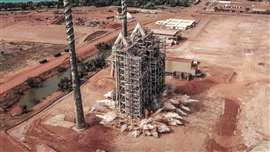VIDEO: How the explosive demolitions at the Gove Refinery went down
08 October 2024
Liberty Industrial has revealed how it carried out two explosive demolitions at the Gove Refinery Closure Project in the Northern Territory, Australia, which is considered to be one of the largest demolition undertakings in Australian history.
The explosive events brought down the site’s Liquor Purification Modules (SLC Units) on June 23, 2024 and two Calciners on July 7, 2024.
Simon Gill, Director, Liberty Industrial, said: “In close partnership with the Rio Tinto Gove Closure Project team, Liberty Industrial has worked tirelessly over the past 12 months in preparation for these two blast events, delivering world-class planning, bespoke demolition methodologies and pre-weakening activities, to deliver two safe and successful blast events.”
 The SLC Units were brought down using 75kg of explosives. (PHOTO: Liberty Industrial)
The SLC Units were brought down using 75kg of explosives. (PHOTO: Liberty Industrial)
Liberty Industrial used its engineering and explosives expertise to carry out the two precise blasts, which were conducted safely and without affecting nearby infrastructure, such as export conveyors.
The contractor said: “The proximity of the export conveyors was a critical consideration when developing our methodology.
“Utilising our inhouse engineering and explosives team, supported with SpaceGASS modelling for structural stability at the pre-weakening stage, and our ASI Extreme Loading Software to develop and refine the induced collapse method and to show the accurate collapse mechanism and resulting debris pile upon initiation of explosives.”
One of the challenges faced in preparing for the demolitions was the lack of complete structural data. To overcome this, Liberty Industrial combined laser scanning with physical inspections to develop accurate cloud-based models of the as-built structures. The approach allowed for the safe and controlled demolition of the SLC Units.
The demolition of the SLC Units involved the use of 75 kg of explosives to bring down 24 columns. These units, which weighed around 2,500 tonnes and measured 47.9 m high, 13.4 m wide and 41.3 long, were demolished after months of preparation, including structural pre-weakening activities such as Oxy Cutting, wire rope pulling techniques and mechanical demolition.
 The Calciner Units were identical, each measuring 49.8 m high, 21 m wide and 39.2 m long. (PHOTO:Liberty Industrial)
The Calciner Units were identical, each measuring 49.8 m high, 21 m wide and 39.2 m long. (PHOTO:Liberty Industrial)
Similarly, the two Calciners - each weighing approximately 3,700 tonnes and measuring 49.8 m high, 21 m wide and 39.2 m long - were demolished using 80 kg of explosives, which displaced 26 columns and brought the structures to the ground.
The pre-weakening phase included the use of high-reach demolition excavators to prepare each of the Calciners, which were separated into four standalone structures.
Following the demolitions, Liberty Industrial began downsizing the debris for recycling using its 200-t excavators and specialised shears. Shipments of the resulting material is currently underway and is expected to continue throughout 2024.
CONNECT WITH THE TEAM










